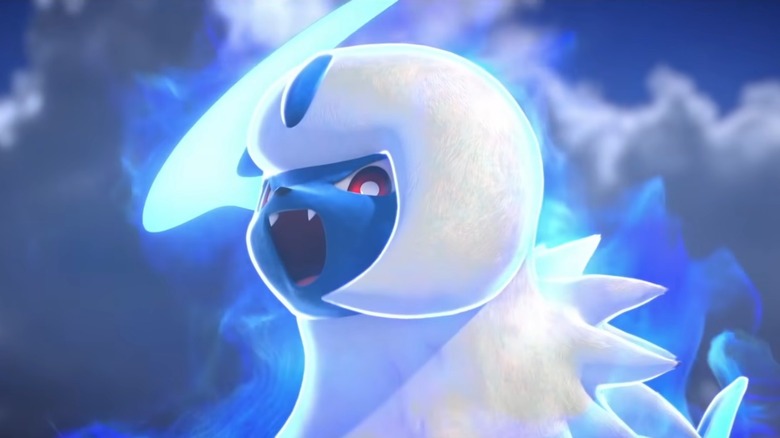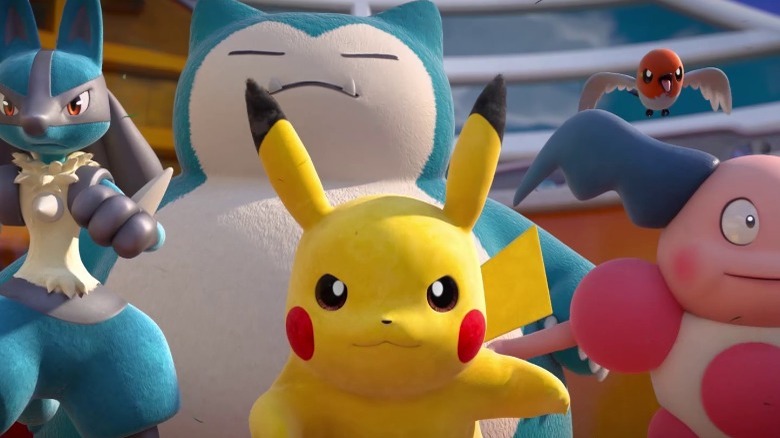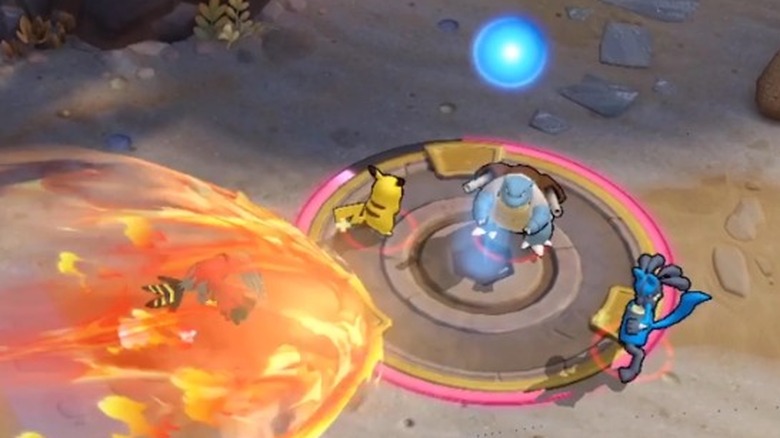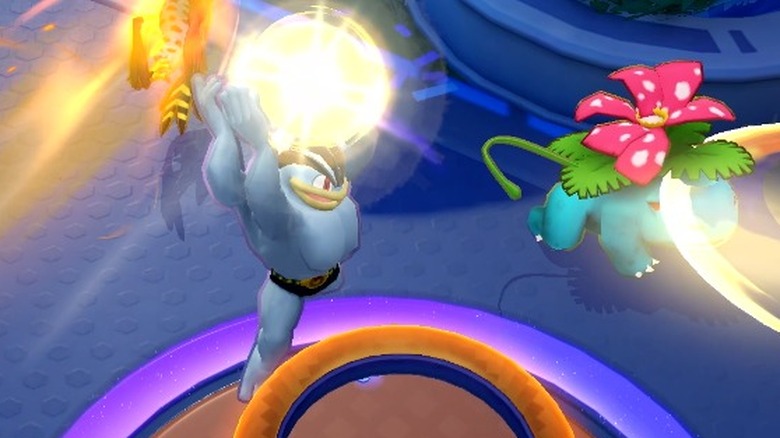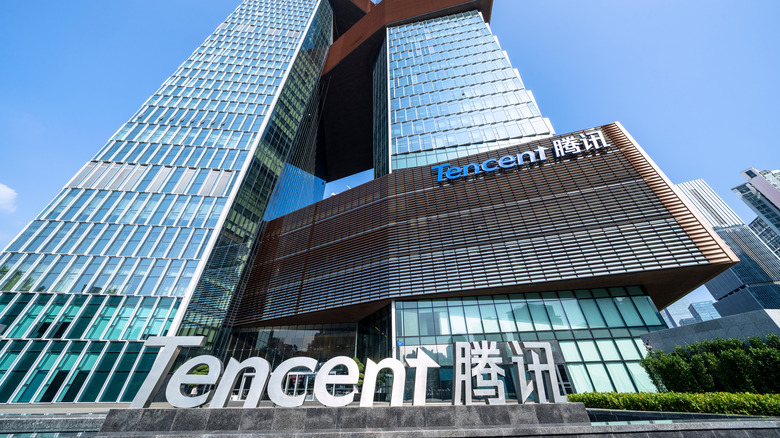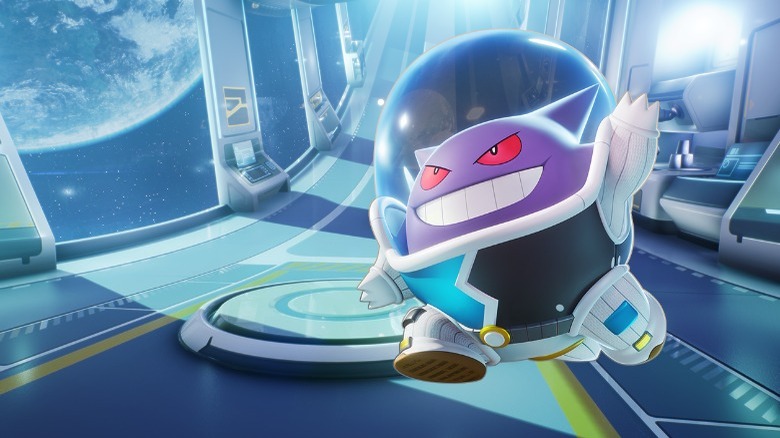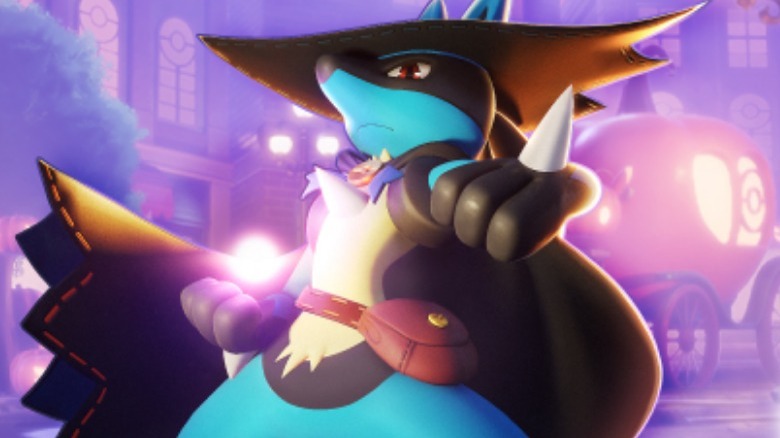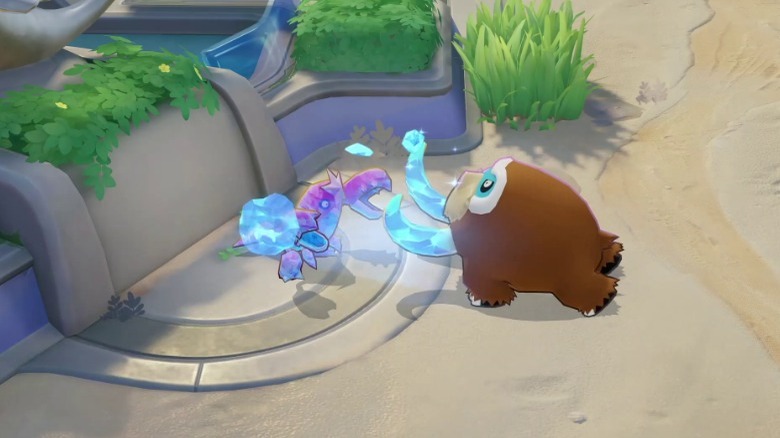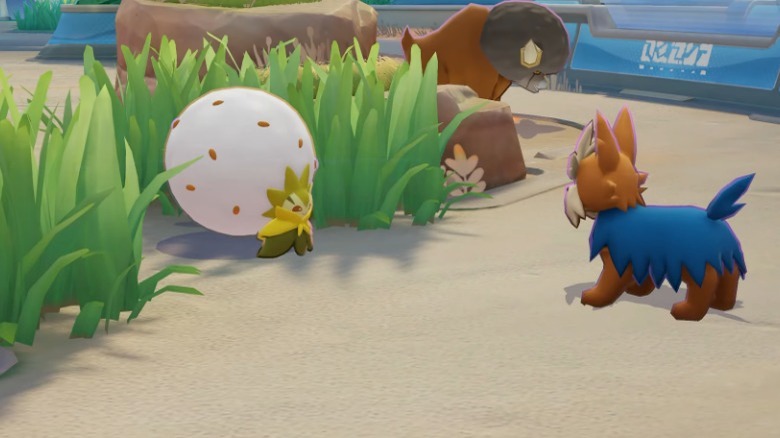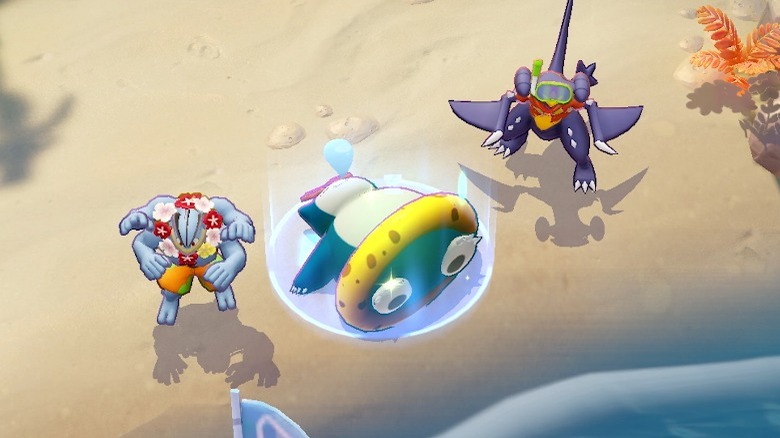Things Only Adults Notice In Pokemon Unite
Audiences have come to expect the unexpected from "Pokemon." A pinball game? There's several of those. What about a video game based on the card game based on the mainline "Pokemon" video games? That came out over a decade ago. How about a MOBA? That recent addition is easily the strangest of the bunch, especially when you look at it through the experienced lens of adulthood.
"Pokemon Unite" is the latest spin-off in the globe-spanning franchise of "Pokemon," and it twists the MOBA genre into something fairly novel. Instead of relying on the battle-worn gameplay loop of pummeling opponents and dismantling their bases — the standard for MOBAs — "Pokemon Unite" opts for a more kid-friendly mix of gladiatorial combat and basketball. Players still need to defeat computer and player-controlled Pokemon as per series tradition, but the end goal is to collect points and use them to literally dunk on the competition. Mix in classic mechanics such as leveling and evolving Pokemon — and also immunizing the game from toxic behavior by limiting communication — and you have a MOBA fit for all ages. Well, mostly.
While children are no doubt drawn in by the recognizable Pokemon and quick gameplay, "Pokemon Unite" hides a few secrets that might not be obvious to younger players, especially if they're only interested in scoring hoops as a Pikachu dressed in a hoodie.
Breaking its own evolution rules
Anyone with even the slightest "Pokemon" knowledge has heard its catchphrase, "Gotta catch 'em all!" Of course, Poke-veterans know that slogan is a bit misleading, since some Pokemon can only be obtained through evolution. In fact, discovering new forms (and using them in battle) is half the fun of any "Pokemon" game, and "Pokemon Unite" continues this tradition with a simplified evolution system that fits the game's pace. No elemental stones, friendship ranks, or trading to worry about; just level up and forget. However, sometimes the game ignores its own rules.
Most playable Pokemon in "Pokemon Unite" can evolve, as can many NPC Pokemon. Starters such as Venusaur and Cinderace begin each match in their first forms (Bulbasaur and Scorbunny, respectively), and the same is true for other monsters in "Pokemon Unite," like Garchomp and Mamoswine. Any Pokemon with a "baby" form, however, gets a pass.
Of course, "Pokemon Unite" features several single-stage Pokemon such as Zeraora and Absol, neither of which evolve in the mainline franchise (Mega Evolution doesn't count), but it also treats Pokemon like Pikachu, Snorlax, and Lucario as single-stage Pokemon. Even though these creatures have pre-evolutionary forms in the mainline games (Pichu, Munchlax, and Riolu, respectively), these Pokemon don't evolve at all in "Pokemon Unite." Players can't even evolve Pikachu into Raichu. To make this even more confounding, Blissey and Wigglytuff start each "Pokemon Unite" match as Chansey and Jigglypuff, rather than their respective baby forms, Happiny and Igglybuff.
Apparently, "Pokemon Unite" has something against letting baby Pokemon compete in a MOBA.
Everything is effective
Combat in the "Pokemon" franchise has evolved significantly since Gen 1. Subsequent entries have introduced held items, duo battles, and much more. No matter the additions, every fight revolves around a core system of elemental advantages and disadvantages that requires a spreadsheet to understand. This super-effective design drew players in and has remained consistent throughout the entire "Pokemon" franchise, minus the occasional addition of a new type like Fairy or Dark. Well, almost every entry, that is.
Unlike the mainline games, attacks in "Pokemon Unite" deal the same amount of damage, regardless of type. In other words, all stats being equal, Fire-type attacks in "Pokemon Unite" deal as much damage to Grass-type Pokemon as Water-type attacks. Even the simplified battle system in "Pokemon GO" honors the traditional elemental system and keeps type-advantages/disadvantages mostly intact. The only other title to fully abandon the elemental rock-paper-scissors game like "Pokemon Unite" is "Pokken Tournament," presumably for the same reasons.
Unlike other "Pokemon" games, "Pokemon Unite" only gives participants 28 playable Pokemon as of late 2021 (pre-evolutionary forms don't count). While the available Pokemon display the entire library of elemental types, it seems like someone forgot to balance them. Fairy is the most common type in the game (Sylveon, Gardevoir, Mr. Mime, Wigglytuff, and Alolan Ninetales), while Crustle is the game's sole Bug and Rock-type representative. Ignoring type advantages and disadvantages is almost a crucial part of keeping "Pokemon Unite" matches as fun and as balanced as possible.
Pay to win with microtransactions
It's difficult to talk about "Pokemon Unite" without discussing the Donphan in the room known as monetization. Unlike most "Pokemon" games, "Pokemon Unite" is free-to-play — and with a free-to-play model comes a cash shop. The controversy of mixing "Pokemon" with microtransactions is nothing new, as critics have been just as divided over the eggs in "Pokemon GO." Are they "fun presents" or filthy loot boxes? "Pokemon Unite" is no different, although its critics might have a more objective leg to stand on.
Many items available through the "Pokemon Unite" cash shop should feel familiar to MOBA veterans. You've got your currency boosters and cosmetic items, but you also have held items that boost a Pokemon's stats in battle. The latter are obtained easily enough, especially since the game doles out freemium currency with uncharacteristic generosity. But that's just purchasing the items; players can also upgrade them to provide bigger and bigger bonuses, which is when the game becomes pay to win.
Reddit user Yepthatsawaffle crunched the numbers. In order to fully upgrade an item, players need 2,587 item enhancers for a total of 25,870 tickets. According to Yepthatsawaffle's calculations, in order to fully upgrade a set of three held items without paying a dime, players need to complete 498 days' worth of missions. That's a tough choice: spend almost a year and a half grinding just so Gengar can shave two seconds off its track record, or max out items in less than five minutes with a credit card.
While buffed stats are no replacement for pure skill, if two players of equal talent were to meet on the battlefield, the one with held items upgraded through the power of Visa/Mastercard would probably come out on top.
Tencent
Nintendo and its subsidiaries normally keep their IP to themselves and rarely let third-party studios tinker with them. However, Game Freak and The Pokemon Company seem to be a little more open to collaboration. For instance, Spike Chunsoft handled development of the "Pokemon Mystery Dungeon" spin-off series, while Bandai Namco brought players "Pokken Tournament" and "New Pokemon Snap." Another third-party company was tapped to create "Pokemon Unite," albeit one that is shadier than a Runerigus.
"Pokemon Unite" was developed by Timi Studios, a subsidiary of Tencent. Timi Studios has a history of developing MOBAs like "Arena of Valor," which is the most successful MOBA to date. Letting a company like that handle a Poke-MOBA sounds like a no-brainer — at least until you start diving into Tencent's seedy side.
While Tencent isn't as overtly shady as Activision Blizzard, it smells of anything but roses. Tencent has bought out companies such as Riot Games and Funcom, just to name a few. However, it's also been blasted for apparently copying games. "Arena of Valor," back when it was called "Honor of Kings," was viewed as a reviled "League of Legends" clone, as noted by Tech In Asia — ironic, since "Honor of Kings" launched after Tencent acquired Riot Games. Many an eyebrow was also raised when Tencent delisted "PlayerUnknown's Battlegrounds" in China and immediately released "Game for Peace," which is "PUBG" in everything but name. The fact that Tencent helped pave the way for the microtransactions plaguing the modern mobile market is another factor that gives players pause.
While "Pokemon Unite" is anything but a lazy clone of other MOBAs, audiences familiar with Tencent's history have been put off by the game's association with the company.
Even when you aren't paying to win, you're paying too much for cosmetics
Contemporary "Pokemon" games have discovered and weaponized the power of character customization. Players can make up for the protagonist's lack of personality (and dialogue) with a sizable wardrobe. The idea of using this customization for each Pokemon sounds neat, because who doesn't want a Charizard wearing a top hat? But that level of freedom isn't feasible for the main games, given the sheer number of collectible creatures. While "Pokemon Unite" fills that void and lets trainers play dress-up with their Pokemon, the game also unfortunately puts the "cost" in "costume."
Like many freemium games, "Pokemon Unite" confuses its users with a cavalcade of currencies, not all of which are created equal. Coins can be obtained through battles and can purchase held items and Pokemon licenses. Meanwhile, tickets are earned through events and can be traded for held items, licenses, and trainer clothes. But then there are Aeos gems, which can only be bought with real money and can be exchanged for tickets, player costumes, boosters, and Pokemon outfits known as Holowear. Since the Holowear vender only accepts gems, trainers who want to glow up their Pokemon have to crack open their wallet.
The most basic Holowear outfits go for as low as 350-400 gems, which cost around $8 USD ($4 if it's a first-time gem purchase). The snazzier Holowear costumes, which also include bonus animations and sounds, can cost 1,050-1,200 gems, or about $20. Gamers who want the most luxurious Holowear threads need to shell out a whopping 2,499 gems, which comes to $40.
As reported by Dexerto, it would be an understatement to say the real-world price tag on many "Pokemon Unite" cosmetics has divided audiences.
Lucario and the Mystery of References
Most costumes and Holowear in "Pokemon Unite" follow generic, downright cliched themes. For instance, trainers and Pokemon alike can don pirate costumes, astronaut outfits, and beachwear, but some costumes are a bit more specialized. For instance, Blastoise can wear a firefighting coat, but even those costumes are still general concepts. All except Lucario's, that is.
Players who logged on to "Pokemon Unite" during its Halloween 2021 event could purchase the special "Costume Party style" Holowear for Lucario. This costume sports a stylized cap and cape, as well as a hip pouch, completing a look that resembles some anime cross between "Phantom of the Opera" and "The Three Musketeers." Newcomers might not recognize the threads, but longtime "Pokemon" fans should realize them as one big reference.
If Pikachu is the mascot of the entire "Pokemon" franchise, then Lucario is the mascot of the fourth generation of "Pokemon" games. As such, it received its own movie, "Lucario and the Mystery of Mew." In that film, Ash releases a Lucario sealed in a medieval crystal staff — which previously belonged to an ancient hero who wore a stylized cap and cape, along with a hip pouch. While the Costume Party style Holowear is missing several features, including the gloves and the symbol on the hat, it is otherwise a dead ringer for that hero's getup.
At the time of the event, Lucario's unique costume in "Pokemon Unite" was the game's first and only reference to other characters from the wider "Pokemon" franchise. Although, given the MOBA's live service nature, it's hopefully only a matter of time until the developers add more. Who wouldn't want to see a Pokemon rocking Miror B's signature afro?
Many attacks and abilities follow their own rules
The history of "Pokemon" attacks is one of trial and error. For example, in Gen 1, Dragon-type Pokemon were supposedly weak against Dragon-type moves, but the only true Dragon-type move back then was Dragon Rage, which only dealt 40 points of damage across the board. And while other Dragon-type moves were added in subsequent games to make up for that oversight, Dragon Rage itself has remained mostly unchanged. In fact, many attacks remain static throughout the series. "Pokemon Unite," however, is an exception.
During the heat of a battle, most players probably don't have time to actually think about which moves to pick, let alone read their effects. While most function the way they do in the mainline games, others were altered to fit MOBA mechanics. For instance, Flare Blitz is a popular Fire-type attack that is guaranteed to hit like an exploding truck at the cost of some recoil damage — a small trade, all things considered. In "Pokemon Unite," the move is fairly weak but gives Charizard a damage-absorbing shield. That's the opposite of the mainline's attack in every way possible.
Abilities were also altered to fit the MOBA mindset. For instance, Levitate is a godsend while battling opponents who use entry hazards and Ground-type moves, but hazards and type effectiveness don't exist in "Pokemon Unite." What good is an ability like Levitate in a game that removes everything it counters? In the case of Gengar, the ability lets the ghost speed along the arena while not in combat, not unlike a bicycle.
You might be surprised to learn what was changed for the sake of genre balance in "Pokemon Unite."
Hiding in tall grass
Even though "Pokemon Unite" is a MOBA, it cherry-picks what it wants from the genre's playbook. For instance, while the game abandons the traditional objective of destroying opposing bases, it keeps classic tactics such as hiding in grass. Not only does this let MOBA veterans retain their honed "jungling" skills, it also plays double duty as a "Pokemon" reference.
In "Pokemon: Let's Go Pikachu" and "Let's Go Eevee," as well as "Pokemon Sword" and "Shield," players can see wild Pokemon before they are sucked into combat. This takes a lot of guesswork out of wild battles and lets trainers choose what they fight and when. However, players who started with those titles might wonder why "Brilliant Diamond" and "Shining Pearl" abandoned that system. Why can't trainers see wild Pokemon before it's too late anymore, and how does knee-high grass hide a 28-foot snake made out of boulders? Because that's how "Pokemon" games used to work.
Prior to "Let's Go Pikachu/Eevee," players primarily encountered wild Pokemon randomly in tall grass. Players never knew what they would find or when, only that stepping into the green patches meant an inevitable battle with something. Virtually any Pokemon could hide in the grass, but they'd be completely hidden until the screen started flashing and the battle music bass started playing. That is essentially how grass works in "Pokemon Unite" — opponents can't see if your Pokemon is hiding in the tall grass.
It's not every day a mechanic in one game references another mechanic in an entirely different game — or genre.
Bots help give you an easy win
MOBAs are not easy games. In fact, the only thing "easy" about them is losing, since players need to work with their teams to overcome opposing players and their teams. All it takes is one bad matchup either against a talented squad or with a lousy ally to ruin a match. Sometimes, bad luck breeds more bad luck, resulting in a string of losses that could convince players to permanently swear off the game. However, "Pokemon Unite" has a secret weapon to keep audiences hooked: bot matches.
Now, most MOBA players look at bot matches with scorn. If not enough real players fill out a lobby, many games, "Pokemon Unite" included, plug up the holes in teams with AI-controlled allies that are so unintelligent they make Luvdisc look useful by comparison. These bots even invade ranked matches in "Pokemon Unite," so Arceus help you if you get paired up with one. However, therein lies the secret "Pokemon Unite" uses to prevent players from uninstalling the game in a fit of ragequit.
Countless players have reported that if someone is in the middle of a losing streak, "Pokemon Unite" seemingly throws them a bone by tossing them into a bot match cleverly disguised as a bout against real players. These fights are almost impossible to lose, and they give players an extra kick of confidence, as well as points to help maintain their rank. Of course, some gamers think these bot matches are an insidious and dishonest way to keep gamers playing.
While these easy-win bot matches might help players keep going if they start believing the matchmaking system is rigged, can the fights really be considered victories if they are actually rigged?

